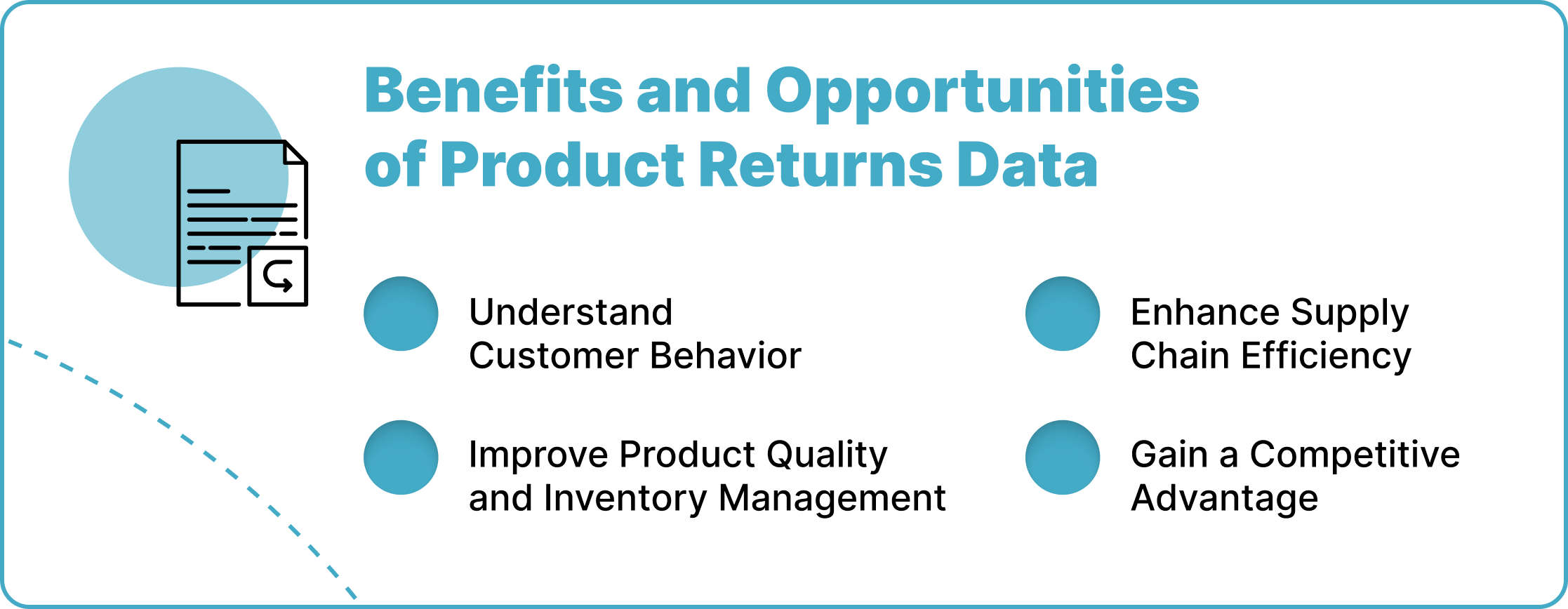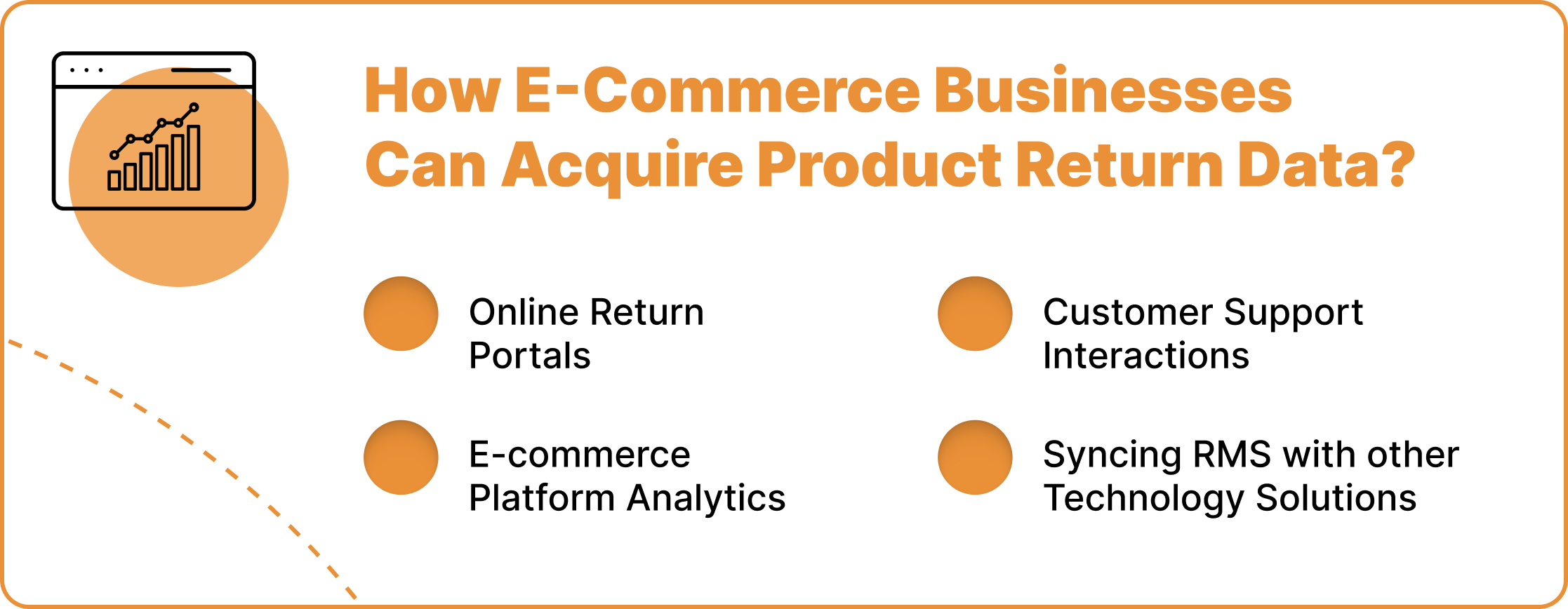Product Returns Data: Benefits and How to Get Them

Returns are becoming increasingly common, with customers sending items back for various reasons — whether due to their own mistakes or other factors. Leveraging product returns data helps businesses uncover the root causes and make informed improvements. Understanding the return policy can also help businesses enhance the returns experience.
The product returns data plays a critical role for businesses and supply chains because it allows them to understand the customer’s pain points. However, it goes beyond that. For a customer to return to work, various processes are involved in the reverse supply chain, and sometimes these processes do not work as expected, potentially impacting the customer experience.
These shortcomings can be navigated by leveraging vital information contained in product returns data. This article explores product returns data, including its benefits, opportunities, and how to obtain it.
Understanding Reverse Logistics
1. Definition of Reverse Logistics
Reverse logistics refers to the process of moving goods from their typical final destination for the purpose of capturing value or proper disposal. It encompasses all operations related to the upstream movement of products and materials, including returns, repairs, refurbishments, and recycling. Reverse logistics is an essential part of supply chain management, as it helps businesses recover value from returned products, reduce waste, and improve customer satisfaction.
2. Importance of Reverse Logistics in Business
Reverse logistics is crucial for businesses, as it can help reduce costs, improve customer satisfaction, and increase revenue. By implementing an effective reverse logistics system, businesses can recover value from returned products, reduce waste, and enhance their overall supply chain efficiency. Additionally, reverse logistics can significantly improve the customer experience by providing a convenient and hassle-free return process. This not only boosts customer satisfaction but also fosters customer loyalty, making it a vital component of modern supply chain management.
The Returns Process
1. Overview of the Returns Process
The returns process starts when a customer decides to return a product and ends when the business collects, sorts, and restocks that product. This process involves several critical steps, including verifying the product return request, creating a return request, processing payment, completing the return, and returning the item to inventory. Optimizing the returns process can be achieved by implementing a clear return policy, having backups to handle returns without receipts, offering store credit or gift cards in place of cash refunds, tracking return rates, and using integrated software to streamline the process. By focusing on these areas, businesses can ensure a smooth and efficient returns process, ultimately enhancing customer experience and improving inventory management.
Benefits and Opportunities of Product Returns Data

Product returns data allows businesses to access various aspects of the returns process through the eyes of the customers. This way, they can:
Tracking the return rate can help businesses improve their reverse logistics process.
1. Understand Customer Behavior
Customers generally do not act sporadically, especially when making particular purchases and returns. In most cases, there is always a reason. If customer returns are reducing or increasing with every sale, there is always a reason behind that behavior.
The problem is that these reasons often go unnoticed when there is a lack of product return data or when the businesses involved do not understand the data on the ground. It is important to always remember that whatever the reason behind the returns, it will be contained in the product return data. It will only take understanding the data to manage those behaviors.
Understanding customer behaviors and return reasons goes a long way to enhancing their experience while interacting with the business. For instance, if there are problems with a lack of transparency or poor product descriptions that give the wrong expectation, these problems can be corrected, thus allowing the business to enhance customer loyalty.
2. Improve Product Quality and Inventory Management
Through product returns data, it is easy to identify the products easily returned by customers and why that is the case. For instance, if a certain product is returned because of poor quality or because it doesn’t do what the business promised, the supply chain can go back to the drawing board or take steps to fine-tune that product to meet expectations. A clear return policy can help in identifying and addressing product quality issues effectively.
If a product is often returned for various reasons, the business may want to discontinue it and enhance the entire inventory management process. Imagine spending money on holding costs for products that are continuously returned. This will significantly impact the cost of supply chain operations in the long run.
3. Enhance Supply Chain Efficiency
Reverse logistics management can be complicated, especially because they work simultaneously with the main supply chain operation. These processes can be severely limited when complications are present, which are caused by a lack of transparency, poor communication, and total negligence.
The problem is that businesses do not flag this on time except when customers complain, or it shows up in the product returns data. By leveraging this information, businesses or organizations can determine the problem and make informed decisions about streamlining or resolving it. Monitoring the return rate can help in identifying inefficiencies in the supply chain.
4. Gain a Competitive Advantage
The market is highly competitive, especially in the e-commerce space. One of the best strategies for standing out is offering return options, especially when they are free. However, free returns will not do much for businesses if they do not streamline and optimize the entire process. The best way to do this is by leveraging information from product returns. Return options are great, but nothing beats a well-run return option. Additionally, a customer-friendly return policy can provide a competitive advantage.
How E-Commerce Businesses Can Acquire Product Return Data?

Leveraging product return data is critical in optimizing the entire reverse logistics process and returns management operation. However, that won’t happen without acquiring the information. So, how can businesses acquire this information?
Tracking the return rate can help e-commerce businesses understand customer behavior.
1. Online Return Portals
Ecommerce returns data is one of the easiest to get because various solutions can seamlessly integrate with it. Take customer portals, for example. These portals are very common on e-commerce and online sales platforms and are often integrated to enable customers to streamline the entire process. They allow seamless interactions between customers and the business, especially during the return process.
But it also serves as a hub for product return data. Businesses can use it to conduct surveys and inquire from customers about their return reasons or about their experience with the entire return process. It is a reliable form of data acquisition because it connects customers with the business, ensuring there are no filters and manipulation.
2. E-commerce Platform Analytics
With technology solutions such as AI and machine learning, more online retailers and e-commerce platforms can seamlessly analyze information on customer behaviors across the entire platform. Analyzing the return rate can provide insights into customer behavior.
These include the type of products they are returning, how many days after purchase they are making the returns, and the nature of the products when they are returned. Analyzing e-commerce platforms is a powerful method of tracking customers’ true intentions and actions as they engage with the platform.
3. Customer Support Interactions
Customer interactions are a great way for businesses and their supply chains to acquire vital product return data. However, to do this effectively, a robust customer service support team equipped with state-of-the-art technology solutions, such as emails, AI chatbots, and machine learning, that can record and analyze customer complaints and return reasons in real time is essential.
A robust and efficient customer support will also ensure customers are attended to at critical times irrespective of the hours. Businesses can and will often find that they can gain vital information about their pain points during these critical times. Beyond just being a source for product returns data, it is also crucial for enhancing customer satisfaction.
4. Syncing RMS with other Technology Solutions
The RMS platform is critical for enhancing how businesses process returns. However, it comes in different categories. One of the cool things about ReverseLogix’s return management system is that it can sync with other technology solutions, such as the WMS and TMS. It can also sync with many other software and applications leveraged by third-party logistics providers, giving the business a full scope of the operations and their shortcomings. Syncing RMS with other systems can help track the return rate more effectively.
This way, the business can easily identify operational shortcomings before becoming a customer problem. Getting the root cause will also be easy when the business understands the problem.
How ReverseLogix Provides Businesses With Accurate Reverse Logistics Data
ReverseLogix solutions work for any business in the retail industry, 3PLs, manufacturers, or e-commerce platforms. Our RMS solution comes with a host of features that empower businesses to collect and analyze product return data accurately. With ReverseLogix, your business can access several cool features, including automation of the return management process, customer service, and analytics and tracking. ReverseLogix helps businesses track the return rate accurately. Connect with us today to see the difference.
Frequently Asked Questions
When tracking or analyzing product return data, it is important to consider the following metrics: return rate, return reasons, return costs, cash refund value, and customer lifetime value.
By analyzing reasons for returns related to defects or quality issues, businesses can identify areas for improvement in manufacturing or sourcing. These areas may include waste management, logistics management, or packaging management. Getting all of them right will help reduce future returns and enhance customer satisfaction.
Yes. Analyzing return data can reveal customer preferences and buying patterns, enabling businesses to tailor their marketing efforts and product recommendations more effectively. This can help increase customer engagement and drive conversions.
